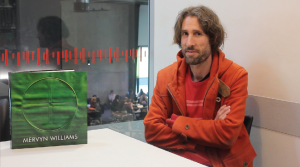Exhibitors, lost for words
The extraordinary exhibition Lost For Words premiering Ed Hanfling’s book – Mervyn Williams; From Modernism to the Digital Age, was viewed by the public last month at Auckland University. Spectators were submerged into the abstract art and were have said to be consistently astounded by the work.
“The opening function was very well-attended, with many contemporaries of Williams’ attending – other artists of his generation and younger – and also a good turn out of academics from the university, e.g. from Department of Art History.”
The exhibition, that ran from September 6th to October 4th, focused specifically on four phases of Williams’ fifty-year career.
The Op Art-inspired paintings of the 1960s and 1970s, the textured paint surfaces of the 1980s and the monochromes of the 1990s.
Each chapter displaying all of the unique and adventurous techniques of which Williams produced. Early in his career he had a fascination with Impressionism and Post-Impressionism.

This led Williams to explore the methods of visual perception. He discovered so many miraculous ‘illusionary’ techniques that he discussed at the exhibition.
Lost For Words was a major stepping-stone in Williams’ Career
The book is thoroughly illustrated with more than 250 color plates.
It was Carefully curated by Art historian and critic Ed Hanfling and published by Ron Sang Publications
“Every time I look at his art I see something different. That is what compelled me”
It was generated over a time frame of 3 years “it was the smoothest processed book,” Hanfling says, he “has ever had the privilege to be involved with.”
Parnell gallery names it the first ever “in-depth survey of the long and varied career of this pioneer of Abstraction and Optical Art in New Zealand.”
Hanfling says he was “compelled to shorten text” so that not much information about the art is given away. This gives the observer a chance to create an image of his or her own.
Art historian Hanfling Identifies Williams as having “perfected a method of chiaroscuro painting based on Renaissance techniques, giving rise to a powerful illusion of high relief and three dimensionality.”
The goal was to achieve this outcome through the exhibition, critiques and exhibitors calling it “unique and original” and “exactly what they wanted.”
There will be no doubt that when the history of abstract art in NZ comes to stand out and be revised that Williams will be acknowledged.




